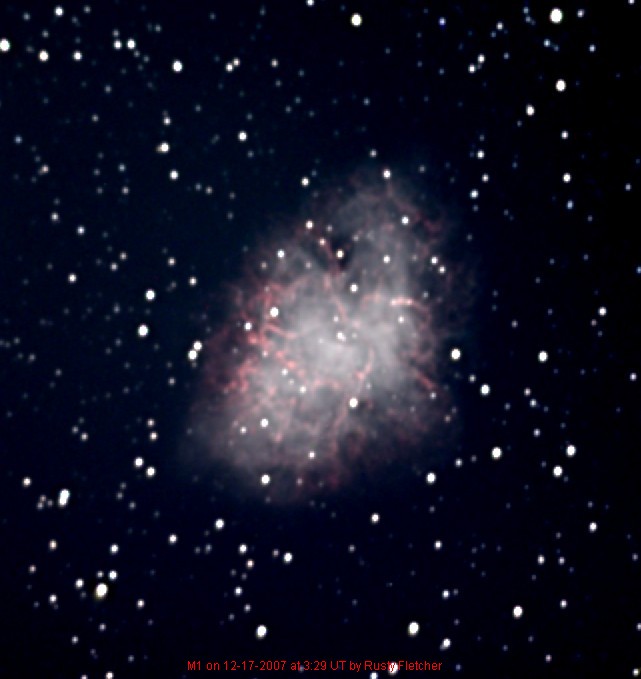
To zoom in or out on a computer, hold down the Ctrl
key and scroll with the mouse, or you can press the + or - key. On a smart phone
use 2 fingers.

M1, THE CRAB NEBULA on 2024-10-04+05+07
The Crab Nebula is a beautiful supernova remnant. The supernova was noted on
July 4, 1054 A.D. by Chinese astronomers, and was about as bright as the Full
Moon, and visible in daylight for 23 days. It was probably also recorded by
Anasazi Indian artists (in present-day Arizona and New Mexico), as findings in
Navaho Canyon and White Mesa (both AZ) as well as in the Chaco Canyon National
Park (NM) indicate. Known as Supernova 1054, it was also assigned the variable
star designation CM Tauri. The nebulous remnant was discovered by John Bevis in
1731, according to Messier, who independently found it again on August 28, 1758.
Messier first thought it was a comet. Of course, he soon recognized that it had
no apparent proper motion and cataloged it on September 12, 1758. It was
christened the "Crab" due to a drawing made by Lord Rosse about 1844.
The nebula consists of stellar material ejected in the supernova explosion,
which has spread over a volume in space of about 10 light years. It is still
expanding at a very high velocity of about 1,800 km/sec. It emits light which
consists of two major contributions: A reddish component which forms a chaotic
web of bright filaments, which has an emission line spectrum like that of
diffuse gaseous (or planetary) nebulae, and a blueish diffuse background of
highly polarized "synchrotron radiation", which is emitted by high-energy (fast
moving) electrons in a strong magnetic field. Synchrotron radiation is also
apparent in other explosive processes in the cosmos, e.g. in the active core of
the irregular galaxy M82 and the peculiar jet of giant elliptical galaxy M87.
In 1948, the Crab nebula was identified as a strong source of radio radiation.
X-rays from this object were first detected in 1964 with a high-altitude rocket;
the energy emitted in X-rays by the Crab nebula is about 100 times more than
that emitted in the visual light. Nevertheless, even the luminosity of the
nebula in the visible light is enormous: At its distance of 6,300 light years,
its apparent brightness corresponds to an absolute magnitude of about -3.2, or
more than 1000 times the suns brightness.
In 1968, a pulsating radio source, named the Crab Pulsar (cataloged as NP0532),
was discovered in M1. It has now been established that this pulsar is a rapidly
rotating neutron star. It rotates about 30 times per second. The neutron star
emits pulses in virtually every part of the electromagnetic spectrum from a "hot
spot" on its surface. A neutron star is an extremely dense star, denser than an
atomic nucleus. The neutron star that is the engine to the Crab Pulsar contains
more mass than our sun in a volume only 30 kilometers across. It's rotation is
slowly decelerating by magnetic interaction with the nebula. The magnetic
interaction is a major energy source which makes the nebula shine. In visible
light, the pulsar is 16th apparent magnitude. This means that this very small
star has an absolute magnitude of +4.5, or about the same luminosity as our sun
in the visible part of the spectrum!
This photo was taken in Kyle, Texas, through a 6-inch f/4 Telescope, on a EQ6-R mount, with a ZWO ASI533MC PRO color camera, plus a dual-band H-Alpha & O-III Filter. The processing was done in PixInsight. The total image acquisition time is: 6 hrs 47 min 30 sec.
Previous, Older Photo

M1, THE CRAB NEBULA on 2007-12-17
Done with my 17.5 inch ALT-AZ Scope and SBIG ST-9E CCD camera
Return to https://astronomy.afountain.org/